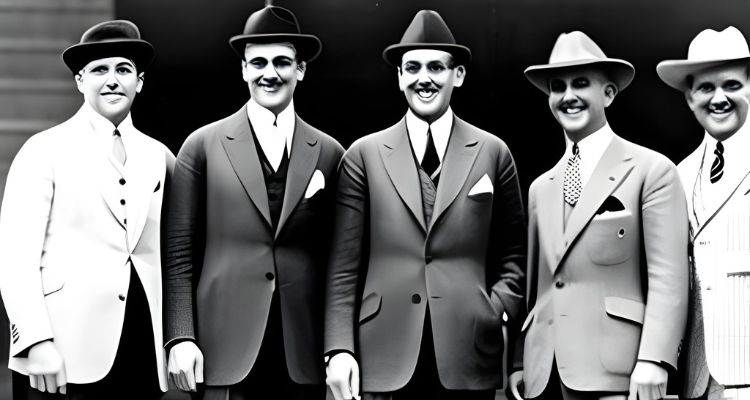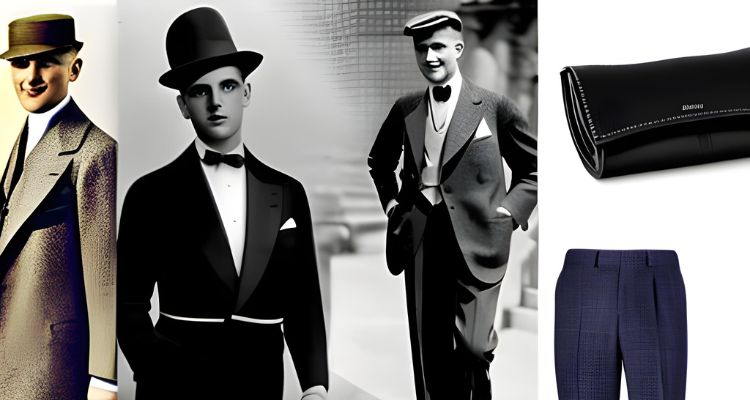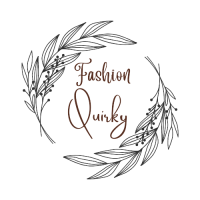The 1920s Men’s Fashion marked a decade of significant cultural and social transformation that heavily influenced men’s fashion. This era introduced new styles, materials, and accessories that revolutionized men’s attire. In addition to offering a fascinating window into the past, understanding 1920s fashion is still important in the context of modern fashion. The 1920s served as a frequent source of inspiration for fashion aficionados and designers, who incorporated its features into contemporary apparel.
This book includes fashionable suits, hats, and accessories from the 1920s as well as advice on how to wear them with contemporary attire to provide readers with a thorough understanding of the period’s menswear. For readers to attain a professional and fashionable style inspired by the 1920s, the guide contains styling advice as well as dos and don’ts.
The target audience for this guide includes history aficionados, fashion lovers, and anybody looking to update their wardrobe with vintage elements. Readers may fully immerse themselves in 1920s men’s fashion and discover the fashion insider tricks of this legendary era with its wealth of knowledge and inspiration.

I. Suits
In the 1920s, suits played a vital role in men’s fashion. Designed to highlight a lean and athletic physique, they were made from lightweight fabrics such as wool, tweed, and linen, perfect for the warmer months. These suits were cut close to the body, featuring high armholes and narrow lapels to create a sleek and streamlined silhouette.
Around this time, the three-piece suit and the double-breasted suit were two prominent suit designs. The former was considered the most formal option, consisting of a jacket, vest, and trousers, while the latter had a more casual feel with a distinctive look sporting two rows of buttons on the jacket’s front.

When integrating 1920s suit fashion into modern outfits, it’s essential to consider fit, color, and style. A well-tailored slim-fit suit can create a modern and chic look, while a looser fit may appear outdated. Neutral shades like gray, navy, and black are timeless options that work well in both 1920s and contemporary fashion. The correct accessories, including a tie, pocket square, and cufflinks, may elevate the appearance and offer a touch of refinement.
Famous personalities such as Cary Grant, Clark Gable, and even gangsters like Al Capone influenced 1920s suit fashion. These days, designers like Tom Ford and Ralph Lauren continue to draw inspiration from 1920s suits, incorporating elements such as slim fits and peak lapels into their designs to create a more diverse range of styles.
II. Hats
Hats were a major component of men’s fashion throughout the 1920s. These hats served both practical and stylish purposes, and there were many different types to choose from, such as the fedora, Homburg, newsboy cap, and straw boater.
Among these hats, the fedora was the most iconic, characterized by its soft felt material and wide brim. On the other hand, the Homburg was a more formal option with a narrower brim and a stiffer material, while the newsboy cap, made from tweed or wool, was a more casual choice. Meanwhile, the straw boater was a favorite during summer, with its lightweight and breathable construction.

Today, incorporating a hat into modern outfits requires consideration of style, material, and fit. A stylish hat may give an outfit a hint of elegance and vintage appeal. However, an ill-fitting or mismatched hat can look out of place.
Notable figures like Charlie Chaplin, Fred Astaire, and Bugsy Siegel popularized 1920s hat fashion. Their influence can still be seen in modern designs, as many fashion designers draw inspiration from the era’s hats, incorporating elements like wide brims and soft materials to create a bursty and perplexing blend of old and new.
III. Accessories
The use of accessories is to improve or compliment a person’s attire or overall appearance. These may include minor accessories like earrings and necklaces and bigger things like bags and caps. A person’s style can be expressed through accessories, which can significantly alter the appearance of an outfit.
Particularly, objects worn on the head include accessories. They might have a practical purpose, like caps that shield wearers from the heat or the elements, or they can be purely ornamental, like hair accessories that give an ensemble a splash of color or glimmer. Among the most popular head accessories, hats, headbands, hair clips, and scarves are used by many people.
The most popular headgear is probably hats. These are available in many designs, including beanies, fedoras, and baseball caps. Many purposes, such as fashion, statement-making, and weather protection, can all be served by the wearing of hats. In addition, they can be worn to conceal bad hair days or to give a splash of color to a monochromatic outfit.

Another widely used headpiece is the headband. The main reasons why people wear them are to express their personal style or to keep their hair out of their faces. Elastic, braided, and beaded headbands are just a few of the various types available. Some headbands can contain bows, flowers, or other embellishments to provide an extra style.
The numerous various ways hair clips can be worn on the head demonstrate their versatility. They can be used to pull back hair, add an extra dash of color or sparkle to an outfit, or style hair in elaborate ways. From basic barrettes to jeweled hairpins, there are numerous varieties of hair clips available.
In addition to hats, scarves are another versatile headwear item. To shield oneself from the sun or wind, they might be worn around the neck or thrown over the head. To add a splash of color or design to an ensemble, scarves can also be used as accessories.
IV. Styling Tips
For a sleek and coordinated appearance, styling advice is crucial. You can make an outfit seem better and feel more put together by knowing how to style your clothing and accessories. Here are some useful pointers to take into account when styling your outfits:
- Understanding Your Body Type: Finding clothing that fits and enhances your form requires an understanding of your body type. Finding the styles that will look best on you and avoiding others can be made easier by understanding your dimensions.
- Pattern Combination: Combining patterns can give an outfit depth and appeal, but it can be challenging. Mixing big designs with small ones and making sure they have the same color is a general design rule.
- Choose Your Accessories Wisely: Accessories have the power to make or destroy an ensemble. Choose jewelry and other accessories that enhance rather than overshadow your outfit. Moreover, take into account the event you are dressing for and select the proper accessories.
- Play About with Layers: By wearing layers, you may give your ensemble more depth and character while being warm throughout the cooler months. Try wearing a blazer over a dress or a button-up shirt layered underneath a jumper.
- Pay Attention to Proportions: While putting together an outfit, proportions are important to consider. To ensure a flattering silhouette, mix, and match fitted and looser clothing, and pay attention to the length of your tops and bottoms.
- Play with Textures: Texture changes can give an outfit more interest. Combine delicate fabrics, such as silk or cashmere, with stronger ones, such as leather or denim.
- Attempting new styles can be frightening, but it can also be enjoyable and gratifying. Don’t be afraid to do so. Don’t be hesitant to experiment with different colors, patterns, and silhouettes, and step outside of your comfort zone.
V. Conclusion
In summary, men’s fashion underwent a tremendous transformation in the 1920s. The end of World War I marked the beginning of a new era in fashion that distinguished itself from the typical Victorian and Edwardian styles of the earlier decades. With the adoption of looser fits, natural shoulders, and high-waisted trousers, men’s suits became more laid-back and comfortable.
In addition, accessories were crucial to men’s fashion throughout the 1920s. Fedoras and newsboy caps became commonplace during the era, and hats in particular were a popular accessory. Suspenders, walking canes, and pocket watches were further accouterments.
The 1920s were also marked by a more casual approach to fashion, with sportswear and leisurewear becoming increasingly popular. This shift towards casual clothing was a reflection of the changing social attitudes of the time, as people sought more comfortable and practical clothing for their everyday lives.
Overall, 1920s men’s fashion was characterized by a sense of liberation and modernity, with men embracing new styles and breaking away from the traditional fashions of the past. Today, the influence of 1920s men’s fashion can still be seen in modern styles, with elements such as high-waisted pants and fedoras making occasional comebacks.
